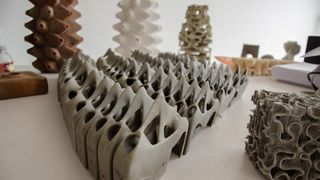"There are a lot of interesting possibilities with this technology and a lot of things you could use it for that have benefit in our daily lives."
Technology still in its infancy
Despite the advances in 3D printing and explosion of new machines, the technology is only starting to hit its stride.
Makers, start-ups, and major manufacturers have barely scratched the surface of where 3D printing can go. Case in point: It was only a few weeks ago that 3D Systems announced the first full-tone 3D printer, letting users create rainbow-colored objects.
While 3D System's 600-pound ProJet 4500 is simply too masive for the average consumer, it's machinery that will likely be employed by 3D printing services such as ShapeWays and iMaterialise. In a few years this color printing technology could be optimized and commercialized in the same way fused deposition modeling (or FDM, the current and popular method of 3D printing with hot extruded plastic) is being adapted for home use.

Beyond the tools, new materials are also being researched. Oakland, Calif.-based Emerging Objects is experimenting with stronger, alternative materials for architectural builds using salt and a fibrous concrete that can withstand 4,500 pounds of pressure.
And looking abroad, Europe is becoming the world's leader in producing new materials. One German 3D printing materials inventor alone has created two revolutionary materials; Laywoo-D3, a composite wood and plastic filament, and Laybrick, a strong enough for architectural builds.
Scanning through the 3D hype machine
Hyperbole is contagious on the web, so it's important to look at the promise of 3D printing with some skepticism. For one thing, it's far from perfect, and botched prints are a dime a dozen. That's not to mention the price or size restrictions we've already run through.
Get daily insight, inspiration and deals in your inbox
Get the hottest deals available in your inbox plus news, reviews, opinion, analysis and more from the TechRadar team.
Still, it's impossible to ignore the enthusiasm of current buyers and future 3D printing developments. Commercial FDM or extruded plastic printers have come a long way from one MakerBot Cupcake CNC machine and a handful of homemades.
Today there are many more affordable printers in the market. At the same time, the industry continues to expand and simplify a database of 3D models for users to fabricate.
Beyond FDM, the world may start moving to other types of technology such as stereolithography, which can create higher-resolution (or thinner layer) objects with light-sensitive liquid resin, or truly self-built circuit boards through laser sintering that melts fine metal powders into solid shapes.
The stage is set for 3D printers to start sitting side-by-side with their inkjet brethren at office supply stores and occupying a coveted spot in our home offices. With the New Year, look for the new-ish tech to take hold.
Kevin Lee was a former computing reporter at TechRadar. Kevin is now the SEO Updates Editor at IGN based in New York. He handles all of the best of tech buying guides while also dipping his hand in the entertainment and games evergreen content. Kevin has over eight years of experience in the tech and games publications with previous bylines at Polygon, PC World, and more. Outside of work, Kevin is major movie buff of cult and bad films. He also regularly plays flight & space sim and racing games. IRL he's a fan of archery, axe throwing, and board games.

